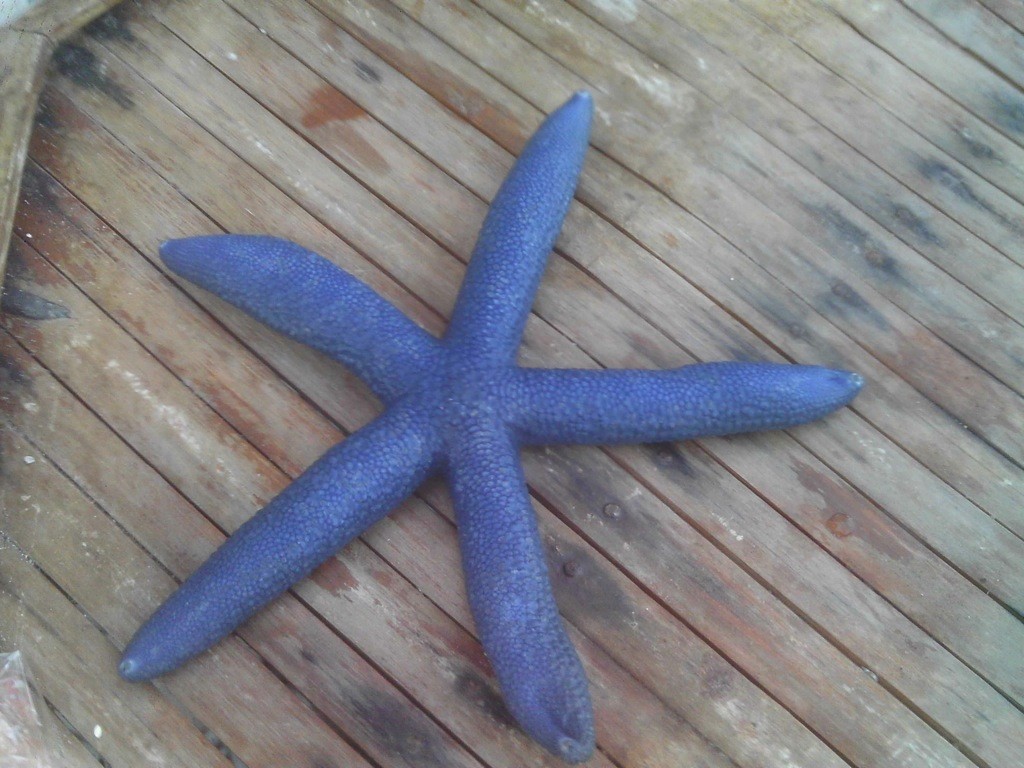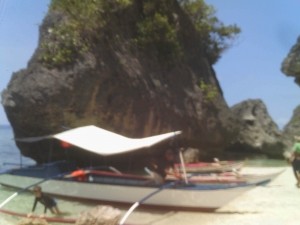Starfish and Shells
Easter Monday, and Marinduque is back into election mode. Banner-fluttering jeepneys pump out the Pilipino answer to Things Can Only Get Better in clouds as toxic as their diesel fumes. Mewls of karaoke waft down the pebble beach. Local party honchos gather over coffee, cigarettes and sweet ham sandwiches in the guesthouse convention room. And Rose pours Klaus his first beer of the day. 9.30am.
So we chip out on a banca, a tall, narrow outrigger with scarlet bamboo poles extending like stabilisers on a bike, to Gaspar Island, one of the three kings which nestle offshore from Marinduque.
This is sufficiently unpopulated to have not an aspirant councillor, Botoxed congressman or optimistic anti-corruption campaigner in sight. It also has one of the nicest beaches ever.
What makes a great beach? Part of it, I guess, is isolation, or the sense of discovery. And part of it, I suppose, is just the day that happens there.
This one is a tiny little cove, nestled between vast chunks of ancient coral, part shaded by limestone cliffs with greenery atop them, with water so clear that bars of golden sunlight dance on the white sand, periwinkle starfishes and coral down below, and humbug fish meander in stripey clouds perilously close to shore.
It feels as though no one has visited for a while. No one lives on the seaward side of the island. And the white sand is quite extraordinarily rich. A single handful turns out violet conches, tiny cone shells studded in scarlet, hot pink and black, nautilus, mother of pearl, baby clam shells, fossil shells, chunks of blue coral scrubbed into soft, porous pebbles by the sea.
The banca slots neatly into one corner, in the shade of an ancient coral slab, and tiny hermit crabs scuttle in the sand.
My mother has always loved to collect shells. She gathers them in utter contentment from the shade of a limestone crag. Grandpa lounges in the shallows, reading. The boys from the boat scale the coral precipice barefoot. And Z, has miraculously lost his fear of snorkelling, heads out to the reef with me.
Snorkelling is something I’ve always loved to do, but I tried to introduce Z to it too young (he was three or four, in Kenya, breathed in water, loathed it). Our second tropical attempt, on Koh Mak, Thailand, was kiboshed by the giant sea urchins, their size entirely amplified by the mask.
This time it really works. He’s off, skinny limbs kicking through a forest of tall seaweed out to the coral jungle of the reef: white oak leaf corals, slow growing patches of bright sulphur yellow, great fat billowing grey-green cushions of brain coral, angelfish, damselfish, humbug fish, zebra fish, giant clams. There is even a regal tang fish, the Dory fish from Finding Nemo.
The sea urchins, some the size of porcupines, with turquoise patterns below their shells, no longer worry him. A stonefish and a livid sea cucumber, in lurid shades of yellow, orange and purple, are far below us, and he knows, in any case, that you never touch the reef.
We’ve developed a take on the standard diving hand code, which enables us to communicate below the surface, and stay immersed in the undersea world. A querying wave of the hand to question whether someone is alright. A circled thumb and index finger with middle finger rising for OK. A triangle to indicate head for home. The cut-throat gesture for trouble. A pointed finger to indicate something worth looking at. A full-hand gesture to indicate the direction we should take.
We drift over the underwater landscape, with slender ravines where the coral drops away, and groupers and tiny sand sharks wait, without concern. We goggle at the giant starfish in shades of periwinkle and aquamarine, the living versions of the one a neighbour took from the coral, before gifting us the corpse.
There is a crown of thorns starfish, too, I am sad to see, spiny and spiky, lurking evilly in shades of puce and purple as it slowly ravages a pad of brain coral.
I realise, also, that Z is now completely at home in water — at least, calm water. We are 70 metres from shore in the South China Sea, in depths of 6-15 metres, and even when his snorkel clip slips and he ships water, there’s not a note of panic. He bats me off, treads water, and sorts the problem out himself.
We eat a picnic of green mangos, watermelon, sharp-sweet tiny yellow bananas, white hen’s eggs, delicious mottled tomatoes, grown for taste not looks, and soft white bread. Pick more shells, and compare notes. Snorkel more. Swim a little. Z persuades his grandfather, who prefers his eyes to masks, to don a snorkel mask for the first time in half a century. And, finally, we head for shore.
I was wondering a while back how you can tell when a child has learnt to swim.
As we near shore, Z takes a leap off the side of the boat. It is clear he has no intention of coming in.
We adults unload the boat. I say to my father, “Shall I stay and watch him while you have your shower, and then I’ll shower later?”
He, who, in a different era, canoed for miles across open sea with his brother, no lifejackets and nary a question of adult supervision, looks at me with ill-concealed surprise. “Well, I don’t think he needs watching, does he? The water’s extremely calm and really fairly shallow.”
And, no, of course, he didn’t.















Mmm, sounds like heaven………
It’s damp and boring here, so this really cheered me up! Good luck on your travels,
Celia.
hello, how much is the banca fare?
From memory, the hotel quoted 1500 for the boat to the island and use of the boat all day: a banca takes six to eight people (they had lifejackets, etc.) you could probably get it down lower for drop and pick-up if you touted along the beach but it seemed fair at the time so we didn’t negotiate. they also brought nice things like umbrellas and stuff…